 |
| Image via List-of-Birthstones.com |
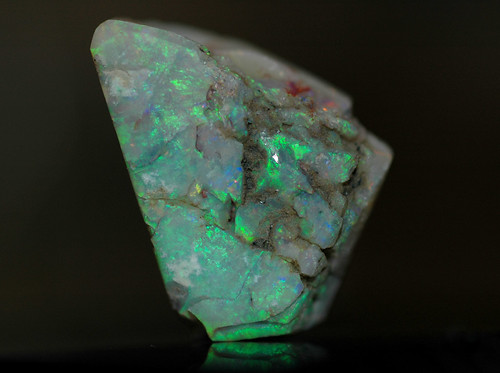 |
| Image by Striving To A Goal via Flickr |
 |
| Image via James Alfredson |
Something a bit different this month for our birthstone. Unlike most birthstones, opals are not a mineral but rather are a mineraloid, which do not have a crystalline structure. Obsidian, a naturally occurring volcanic glass, is another example of a mineraloid. Pearls are the only other non-mineral birthstone.
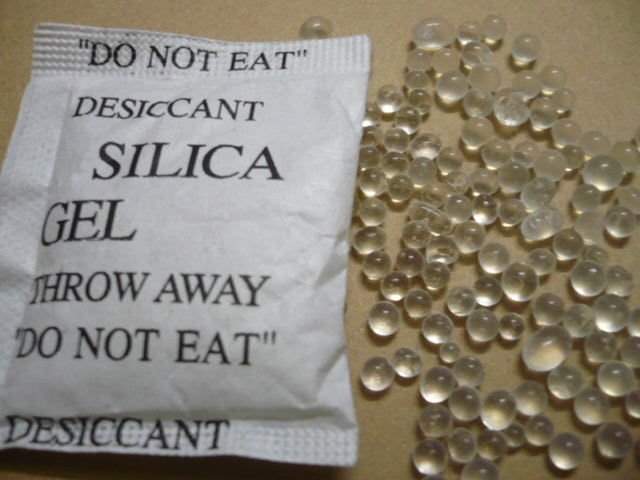 |
| Image via Alibaba.com |
You know those little desiccant packets that seem to come in everything you buy? Silica gel. Silica, silicon dioxide, is the most abundant element in the earth's crust. Sand. OK- no it's not that easy because scientificos can break down and categorize all kinds of things, including silica, but that's the basics of it- sand. Well, opals form when a silica gel- water and weathered silica- seeps down into the cracks and fissures of a host rock, settling at the bottom. This makes opal a sedimentary stone, which form at relatively cool temperatures close to the earth's surface, unlike the deep igneous and metamorphic rocks which require loads of heat and pressure. Diamonds are an example of that type of formation. No, our silica gel settled gently into its new home at the bottom of a pond or other water body and waited for the surface water to recede. Over time the water inside the silica gel began to evaporate and the gel hardened. If the water evaporates quickly, the opal will be less stable. The best example is mud- we've all seen those dried out mud patches with the cracks running across the surface. So it is with opals. These brittle, unstable opals are pretty common worldwide and do not carry a great deal of value. However, if the water evaporates slowly the resulting opals are much more stable and, if the opal has a nice fire to it, will most likely be considered a precious, or gem quality, opal. All opals contain 2-6% water, maybe as high as 20%. A higher water content will result in an unstable opal. But here's a cool thing to think about. That water from some ancient sea or lake or stream that formed the silica gel? Still in the opal!
 |
| Opal in matrix. Image via Ohio State University Newark |
Alright- hold on, let's back up a minute. Fire in an opal? Oh yes, baby, you want fire in your opal. Fire is the term used to describe the flashes of light and color in an opal, the "play of color". Careful- a "fire opal" is any translucent opal, usually with a yellow to orange to reddish background color.
 |
| Left- Black opal with good fire. Image via Steve Perry Gems Right- Fire opal, with good fire. Image via Harlequin Minerals Both gorgeous, right? |
Before we move on, I just have to tell you about another really cool thing- opalized fossils. Sometimes our silica gel will have settled into the cracks and fissure of various bits of bone, teeth, shell, wood, and so forth- any of the things that become fossils. Or these little bits of treasure will fall into a little puddle of silica gel. As the gel hardens, it shapes to or replaces the organic materials and you have opalized fossils. "Neat-o" in the extreme.
 |
| Australian opalized clam shells. Image via Cochise.edu |
 |
| Opalized dinosaur tooth Image via Australian Museum |
Back to the fire in opals. It was previously thought that the beautiful play of color in opals came from iridescence. However, with the invention of the electron microscope gemologists were able to discover the true structure of opals and the source of that fire. As mentioned, opals are a mineraloid, meaning they do not have a crystalline structure. Instead, the silica gel is composed of water and tiny silica spheres. As the gel settles into its host rock (or dinosaur bone- cool!), it can do one of two things. If the spheres are uniform in size and settle into a regular, organized, tightly packed structure, the resulting opal will be a precious opal, meaning it will have the lovely fire, flash, and color so desired in opals. If the spheres are irregular and disorganized, the opal will not have that delicious play of color. At the risk of getting too scientific-y, let me quote from GBJewelers:
When the spheres are the same size and are arranged in a three-dimensional grid, negatively charged areas are created in the gaps between the spheres. If those negatively charged areas are as big as a wavelength of visible light, then colors will be visible. One reason opals with red fire are so popular is because an opal with red fire will also display every other color. Red light has the largest wavelength followed by orange, yellow, green, blue, and violet. If an opal displays red fire, then that means the negative areas between the spheres are as big as the largest wavelength of visible light. As the opal rotates slightly, the colors change as the negative areas become gradually smaller from the viewer’s perspective.
SO it is light diffraction (disruption of light waves when they encounter an obstacle), not iridescence (light reflection from the superficial layers) that gives opal her colorful shazaam because it is the spacing and uniformity- the internal structure- of the silica spheres that determine the play of color, even color.
 |
| Left- organized internal structure of precious opal. Image via Unique Opals. Right- haphazard arrangement of the silica spheres of common opal . Image via Search4Gems. |
Stay with me now because there's one other term that is important to understanding opals: opalescence. As mentioned, "play of color" refers to the colorful sparks and flashes of color that come from a changing viewing angle of long light waves in the opal. The more regular the internal spherical structure, the more red flashes. Red is good. Opalescence is often referred to as "play of color" but they are not the same thing. Opalescence refers to the milky, turbid (cloudy) appearance of a stone. It does not display bright flashes of color but rather a shimmering usually bluish white effect caused by short ligthwaves reflecting within a stone that has larger, more irregular spaces between the silica spheres. I know! Here we are already graduated and on with our lives and what pops up? Science class!!
There are two broad categories of opal: precious opal and common opal. Common opals, or potch, are much more abundant but do not display the play of color so desired in opals and it displays the same colors no matter the angle from which it is viewed. They have opalescence but not play of color (science class now, finally, dismissed).
 |
| Potch opal. Image via Wikipedia |
Precious opals are extremely rare and a top quality precious opal can sometimes fetch $20,000 per carat, far more than diamond. Precious opals can be further categorized though some sources offer differing categories. I'll try to stick with the basics that seem to be universally accepted. Keep in mind that because opals are sedimentary and form across a variety of settings, there are TONS of variations. Also, what we do to opals once they come out of the ground effects how they look. And each type of appearance has its own name. If you visit Real Gems you will see photo upon photo of all kinds of opals (though not by any means an all-inclusive list). There are just so many colors and patterns and they all want their own name. It's confusing but fascinating and I would encourage you to go take a look just to be boggled. But let's go forward and see what we can discover.
There are four basic broad categories of opals: black, light, boulder, and crystal.
Black opals are by far the rarest, most expensive, and without contest the most beautiful opal you will find. These are the dark, fiery, colorful opals that make your heart sparkle and your mind breathe "Wow!" (Can you tell now that I really like opals?) These opals are called "Black" because their background color is black, blue, brown or gray and as we know, that black background gives the best contrast for viewing the colors. That's why jewelers show their wares on black velvet. One site I visited described black opals as "having the look of an angry storm behind a rainbow". (Oh yes, let the peotry begin). Black opals are cut as cabochons in order to fully appreciate their beauty, which can stand up to, even right next to, any ol' diamond you throw at it. Opals, with one exception, also are cut as cabs because they lack a crystalline structure and therefore cannot be faceted. THAT'S why you don't see emerald cut opals.
 |
| Left- Opal & Gem Export, Middle- The House of Tibara, Right- Flash Opal |
Light, or white, opals are the most abundant type of opal. They have a milky white appearance (yes, opalescence but also play of color is present) which can range from near opaque to translucent. The lighter the opal, the more difficult it becomes to see the play of color although some do have plenty of fire. White opals are the least valuable opal but that makes them an affordable option if you simply must have an opal, any opal, just get me an opal! Some of these stones really are quite beautiful.
 |
| Left- Cerca Gems Middle- Lang Antiques Right- Mineral & Gemstone Kingdom |
Boulder opals are the second most valuable type of opal. Boulder opals form when a thin layer of opal rests atop a thicker layer of darker host rock, generally ironstone, and are easily distinguished by the layer of solid brown ironstone left on the back of the stone. Because the layer of opal is so thin, opal cutters need to leave the ironstone on the back of the opal in order to form a full sized stone. Although the ironstone layer providing the backing to boulder opals may appear similar to doublets upon first inspection, the formation is completely natural which makes them so much more valuable than a man-made doublet (which we will discuss in a second). Leaving the layer of ironstone essentially creates a black opal and they are generally priced almost the same. Without the ironstone backing, most boulder opals would be considerably lighter in color, far more fragile, and thus less valuable. Boulder opals can, by far, have the most organic appearance of opals as they are often cut free-form and can have beautiful inclusions of the matrix rock. Boulder opals are cut as one with the host matrix and finished as a single piece piece. Sometimes host rock has opal through out the matrix instead of laid down in a layer. Boulder opals are found in the state of Queensland, Australia.
 |
| Left- Opal Rocks Middle- Real Gems Right- GemSelect |
Crystal opals refer to any kind of opal (black, light, semi-black) that are transparent to translucent and typically have a good clarity which allows a strong diffracted color to be seen. If you can see through an opal, you are probably looking at a crystal opal. Crystal, in this instance, refers to the clarity not the internal structure since we now know that opals are not crystalline. We're getting so smart.
 |
| Left- ECVV Middle- Jewelers Ethics Association Right- Big Island Jewelers |
Fire opals are clear to translucent crystal opals that have little opalescence (the fiery flash) but are instead valued for their color. Their colors range in the warmer yellow, orange, reddish tones. These are the only opals that are faceted.
 |
| Fire Opals Left- Cascade Gems Middle- Osiris Gems Right- International Colored Gemstone Association |
So where can we find opals? Actually, our stone can be found all over the world but it is in Australia that we find most of the spectacular gem quality opals, accounting for an estimated 90% of the world's gem quality opals, 90% of that number being white opals. The most significant fire opal deposits are located in Mexico. Other mines can be found in United States, Peru, and Brazil as well as Turkey, Nicaragua, Hungary, Ethiopia and Guatemala. And, just in case you're up for a little shopping trip, NASA announced in 2008 that it had discovered opal deposits on Mars.
But what about the opal? What about her story and her history? The name opal is thought to be derived from the Sanskrit upala, meaning “precious stone,” and later the Greek derivative “Opallios,” meaning “to see a change of color.” Relatively rare up through the first half of the 19th century, opals were not discovered in Australia until 1849 by German immigrant Johannes Menge. It is widely believed that opal adornments dating back 6,000 years were discovered in Kenya by the archaeologist Louis Leaky. Some argue that these were, in fact, chalcedony or quartz as the body in the burial site had been cremated and the very heat-sensitive opal would not have survived. The first written record of opals dates to 300BC. Opals were being mined in Dubnik, Hungary by 1597 when Emperor Rudolf 11 issued a mining license for the deposit.
Opals were originally considered lucky gems with many powers of a positive nature. In India, opal is thought to be the Goddess of rainbows turned to stone when fleeing from the romantic advances of the other Gods. Many believed that opals would enhance foresight as well as eyesight and some thought its effect on eyesight would render the wearer invisible, making it popular with thieves. Blondes wore opal necklaces to prevent their hair color from fading while others wore opals to clarify their emotions, lessen inhibitions, or enhance spontaneity. Opal was given as a token of hope, purity and good luck. Aborigines believe the opal has a spiritual value. They believe the opal represents something an ancestor left behind as a sign of his or her presence. The Wangkumara people have a legend which tells how their people gained fire from opal stones. During the reign of Queen Elizabeth the opal was regarded as a stone with as many positive virtues as it has the hues and colors of every other stone and brought only joy and good fortune.
| Savoia opal tiara. Image via Colored Diamond Info |
Opals were originally considered lucky gems with many powers of a positive nature. In India, opal is thought to be the Goddess of rainbows turned to stone when fleeing from the romantic advances of the other Gods. Many believed that opals would enhance foresight as well as eyesight and some thought its effect on eyesight would render the wearer invisible, making it popular with thieves. Blondes wore opal necklaces to prevent their hair color from fading while others wore opals to clarify their emotions, lessen inhibitions, or enhance spontaneity. Opal was given as a token of hope, purity and good luck. Aborigines believe the opal has a spiritual value. They believe the opal represents something an ancestor left behind as a sign of his or her presence. The Wangkumara people have a legend which tells how their people gained fire from opal stones. During the reign of Queen Elizabeth the opal was regarded as a stone with as many positive virtues as it has the hues and colors of every other stone and brought only joy and good fortune.
 |
| Image via Irena Daria- One of a Kind Jewelry |
But the winds of change were beginning to blow for our precious opal. Because opals are brittle in nature, they are difficult to fashion and set. Maybe those early jewelers began whispering tales of woe about opals to get out of having to work with them (that's my theory) or maybe it was when Louis XI of France ordered his jeweler’s hands cut off as punishment for the accidental destruction of a royal opal. During the eighteenth and nineteenth centuries, Europe was beset with trouble, including diseases like the Black Plague and widespread famine. Someone or some thing had to be responsible. Rumors began to spread that perhaps the opal brought misfortune. Then Sir Walter Scott went and wrote his book. In “Anne of Geierstein” (1829), Sir Walter Scott wrote that the enchanted character named Baroness Hermione always wore an opal in her hair. This opal was said to have reflected the moods of the wearer; sparkling when she was happy, showing red when she was angry. At some point in the story, the opal was sprinkled with holy water and it immediately went dull and lifeless. The Baroness was taken ill and soon died, left in a pile of ashes on her sick bed. The opal was in ashes as well. Sir Scott's novel was so popular and widely read that the fate of the opal was sealed. Bad luck for the fictional Baroness was bad luck for our beautiful opal.
 |
| Carved opal mermaid. Image via Opal Information Site |
Then, poor opal, black opals were discovered in Australia in 1900. The thinking was initially put forth, most likely by someone whose mine was producing black opals, that if white opals were bad luck their opposite, the black opal, must be good luck. As soon as diamond producers caught a whiff of the increasing popularity of black opals, they sent their Ad Men into overdrive. No, no, no- everyone knows that black represents evil and therefore ..... poor opal.
But some, notably Queen Victoria and Napoleon Bonaparte, loved opals and wore them regularly, in spite of the uproar. Napoleon even had opals set in the crown jewels of France. Slowly, the opal has regained most of its early glory days, though there are still jewelers in parts of Europe who refuse to sell opals. I can remember as a kid with an October birthday being told that it was bad luck to give an opal to anyone who was not born in October. Yeah for me! As the birthstone for October, the opal stands for hope.
Opals are said to enhance self-confidence, strengthen memory, help stimulate originality and dynamic creativity, encourage an interest in the arts, and is a representative of justice and harmony. Overall, the stone is said to be the most useful in preventing bad health. It strengthens the immune system and helps the body be resilient to infection. And it alleviates PMS. Let me say that again, alleviates PMS. Good excuse as any to go shopping, as far as I'm concerned.
 |
| Image via Molecular Expressions |
So we're at the store, ready to rock some opals. What do we need to know when buying opals? First and foremost, check the solidity of the stone. That's right, not all opals are solid, which would be the most desirable yet most expensive stone to buy. Look at the side of the opal. If you see layering, beware, ask questions, check for paperwork. Opals are sold as solid, doublet, or triplet.
Best- a solid opal, no matter if it's black, white, pink, harlequin, fire, whatever, has the highest value (and price tag).
A doublet opal is a thin layer of opal with a darker layer glued to the back. This is usually ironstone, obsidian, glass, potch opal, anything cheaper than the actual opal. A doublet is sometimes created if the layer of opal is too thin to cut or use as a solid stone. This enhances the color and will give a light opal more of a black opal appearance.
A triplet opal is similar to a doublet with the addition of a glass or crystal dome on top. This is done to protect the layer of real opal as well as enhance the opal's overall appearance. Triplet opals are "extremely affordable".
Because opals are non-crystalline and do not facet, except for fire opals, they are generally finished in a cabochon. They should also be set in a bezel or other enclosed setting instead of the more familiar prong setting in order to protect the stone. However, this can make it tricky to see the opal from the side in order to determine its solidity. Shop only at reputable jewelers and ask to see a disclosure for the specific stone you are considering.
 |
| Sometimes, a seller will offer a "genuine opal triplet or doublet". You better believe it! The opal is genuine but the stone taken as a whole is not natural- it is genuine indeed, but assembled. Truth in advertising with a sneaky twist. Image via Rocks On Fire |
Next, evaluate the play-of-color, the range of color, and the background color. The best opals have many different colors, in large flashes, widely dispersed across the stone. Beware of regular grid patterns in the opal's fire as this may indicate a man-made synthetic opal or piece mosaic. Also look at the background. Black opals, which are actually any dark color, such as dark green, dark brown or black, are the most prized. Dark gray, followed by light colored opals are next on the value scale.
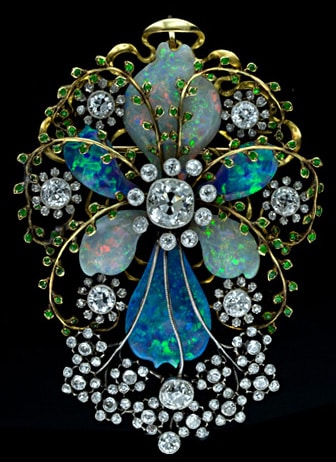 |
| Art Nouvea brooch, turn of the century, $27,500. Image via Lang's Antique's |
Finally, check the size. Solid opals are sold by carat weight; the larger the carat, usually the more expensive. However, the variations of opal colors, both in body color and display color, make a big difference in price. Boulder opals (because of the weight of the ironstone), doublets and triplets should be sold only by the stone, not by weight.
 |
| Boulder opal. Image via Gemology Online |
Some natural opals, but not all, will fluoresce under UV Light. Synthetic opal does not fluoresce. That's right- synthetic. Synthetic solid opal can be very difficult to identify, unless you are an expert or have a lot of experience. Chemically, synthetic is very similar to natural in that it is a hydrated silica gel and is made in the lab under almost the same processes that it took "in the wild" all those millions of years ago. Look closely at the pattern - opal created in a laboratory (Gilson opal) displays large bright patches of color. The pattern is often 'too perfect' and ordered. I make the analogy of the pattern of granite counter tops versus quartz (though I personally prefer quartz for a variety of reasons that have nothing to do with this discussion). Synthetic opals can also often display a 'snakeskin' pattern. If you are still not sure, take it to a gemologist or an opal expert.
 |
| Synthetic opal. Image via Skywalker.Cochise.Edu Would this not make an awesome quartz-like countertop? Opals are, in fact, related to quartz but we just aren't going to start that line of discussion. I already dismissed science class. |
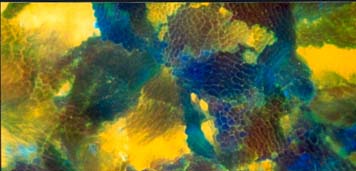 |
| Snakeskin appearance of synthetic opal. Image via Your Gemologist |
Additionally, imitation and simulated opals (as opposed to synthetic) are made of glass, resin, or some other non-siliceous substance. I'm going to send you to Rainbow of the Desert if you would like to learn more about educating yourself about these fakers.
Opals require special care, once you have them safely in your possession. Due to their relative softness, opals scratch and break easily. As with any gemstone, precious or semi-precious, it is best to take it off to do the dishes, weed the garden, change the oil in your car, or play flag football with the kids. Water will not harm solid opals but it can cause the layers of a double or triplet opal to separate. Do not use an ultrasonic cleaner or ammonia. It is best to clean your opal with a soft cloth and a mild- MILD- detergent. No scrubbing. Dry thoroughly. Store your opal away from other jewelery, such as in a separate compartment, to avoid getting scratched. You can also keep your opal in a sealed plastic baggie, even with a cotton ball and a couple drops of water. Do not put them in a safe deposit box as bank vaults tend to have fairly low humidity, which would suck the life right out of your opal. Avoid high heat and sudden changes in temperature. It isn't that opals don't like to be cold, they don't like to suddenly become cold. I read an account of a woman who went outside on a cold winter day with a beautiful opal brooch on her coat. Once she hit that cold air, she heard an audible "crack" as her opal self-destructed. Oh, that makes me sad just thinking about it. Wear you opals often so that they receive the needed humidity from the air and your skin.
OK- best part-- Opal Tour !!
 |
| Best still my heart- Edwardian Necklace. Image via Lang's Antique's |
 |
| World's largest and most valuable precious opal, discovered in 1956 in Coober Pedy, Australia. This extraordinary opal consists of 99% gem opal with an even color throughout the stone. The balance of 1% being the remaining soil still adhering to it. It weighs 17,000 carats and is valued at $2,000,000USD.Image via Altmann & Cherney |
 |
| Left- Boulder opal. Image via Opals On Black Right- Matrix boulder opal- smaller "flecks" of opal in the host rock. Image via Michelle's Opals Australia |
 |
| Image via Gems and Jewelery Lovers Blog |
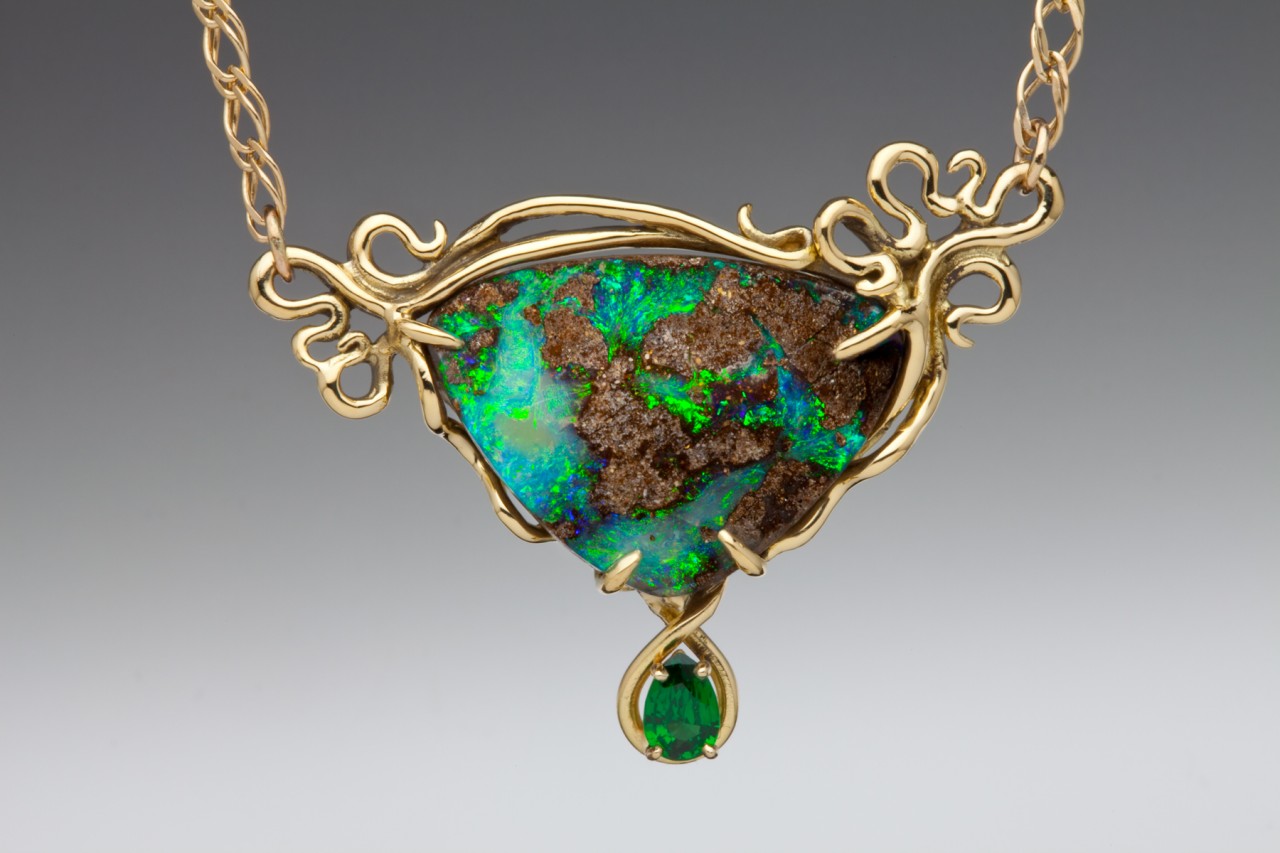 |
| Boulder opal jewelery can often have a very earthy, organic look and is frequently mounted free-form. This stunning babe will set you back $3,800. Image via Marty Magic. |
| In this photo you can see how the silica gel would have oozed down through the rock to settle at the bottom of the fissure. This is a fire opal from Spencer, Idaho. Image via Peregrine Rocks |
 |
| Image via Juniker Jewelry Company |
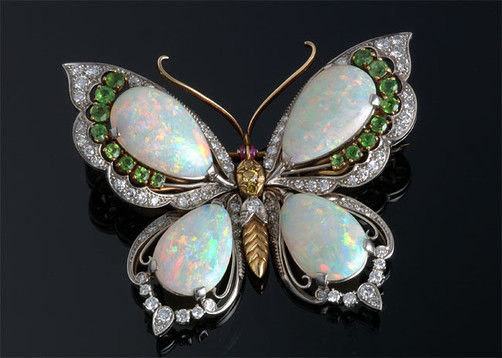 |
| J.E. Caldwell opal & diamond butterfly brooch. $30,000USD Image via Alain Troung |
So there you go- opals galore! As an October baby, I like that opals are somewhat different from the most other birthstones (excepting our gal Pearl, of course) in that they were formed differently- cooler temperatures, close to the surface, generally in the presence of water. And those colors!
I've tried to be as correct as possible with this information but once you start getting into opals- WOW! There are so many kinds and patterns and opinions that it can be confusing. I visited gemology and geology discussion boards on which participants not only had differing opinions but in a couple of cases were barely hanging onto their manners. Passionate about opals! I can understand. I'm not a geologist, though I do find it fascinating, so if you have noticed glaring mistakes, please forgive me. This quite honestly has been the most difficult of our birthstones to post about because there are just so many kinds of opals and opinions about opals. There is even growing discussing about how opals were really formed..... crikey!
So Happy Birthday to all you fabulous October butterflies- hope your day is opalicious!
And thank all of you, regardless of your birthday, for visiting today. I have a funky candle luminary thing to show you next time- just in time to eat, drink, and be scary.






As soon as i finished reading, i sent this on to my sweetie because he is a huge Opal fan! He is reading as I write you and I keep hearing all kinds of vocalizations of appreciation!
ReplyDeleteYou have done another incredible job on this post.
Actually, with the exception of fire opals and white opals, I am NOT a fan of opals because i just think they look - well fake! I know - I am flawed!!!
But i have to say, after reading and enjoying this post, i have learned so much i never knew and gained a much greater appreciation for opals.
I have learned so much from you this year! I have said it before - many times - but one more time, thank you for all your hard work and research and time that goes into making these most excellent birthstone posts.
Really enjoyed this blog post, is there any way I can receive an update sent in an email when you write a new post?
ReplyDeleteIf you go to the top of the sidebar (on the right) there is a place to subscribe. Thanks so much for reading.
Delete